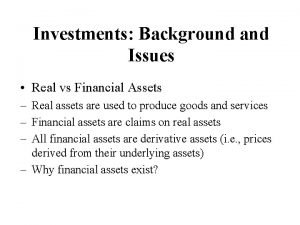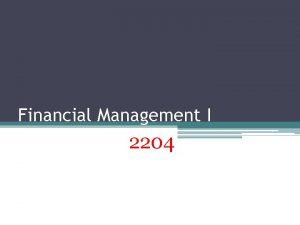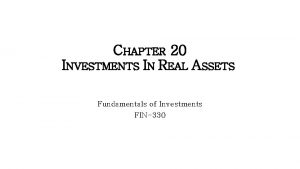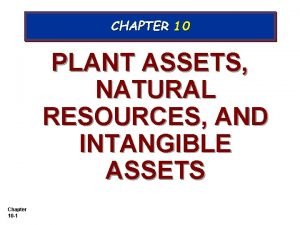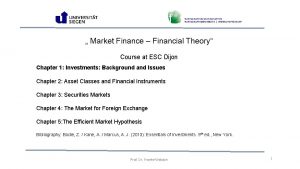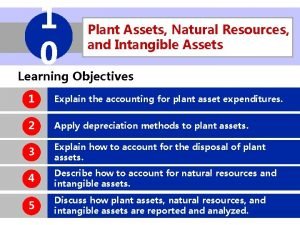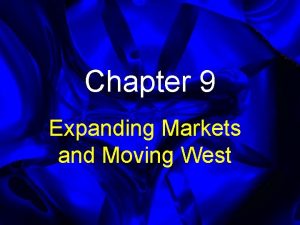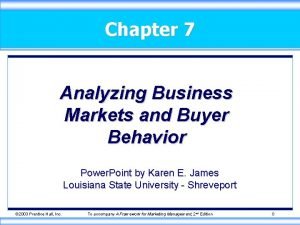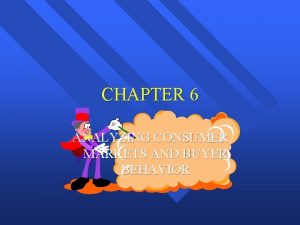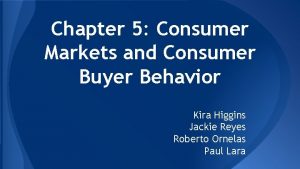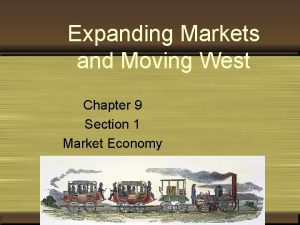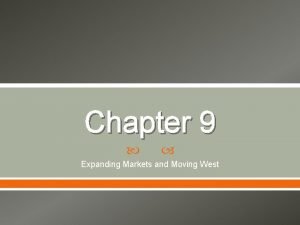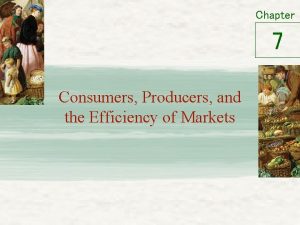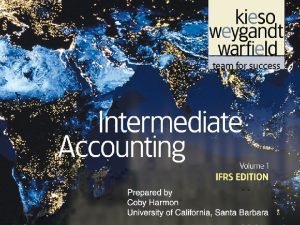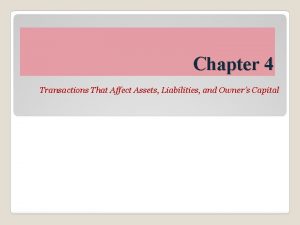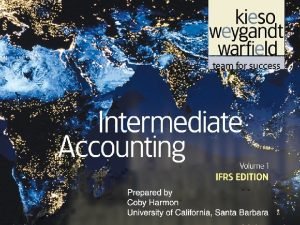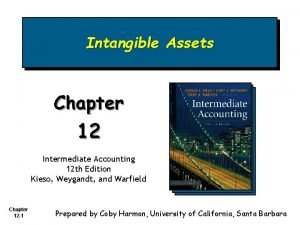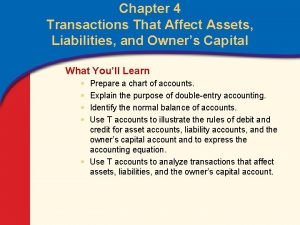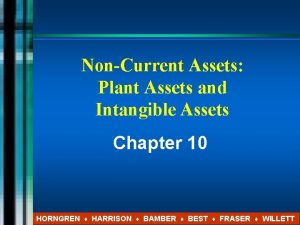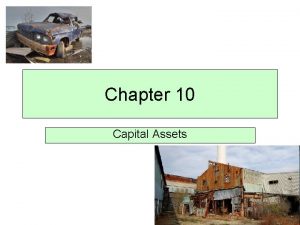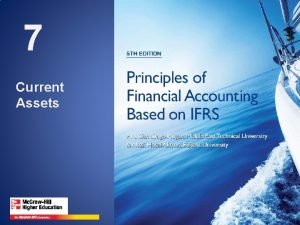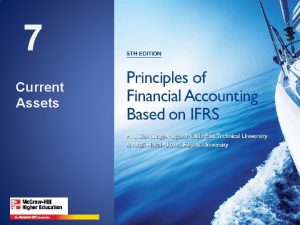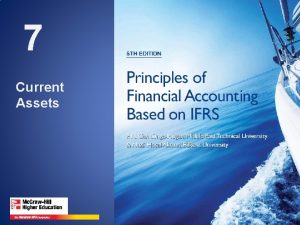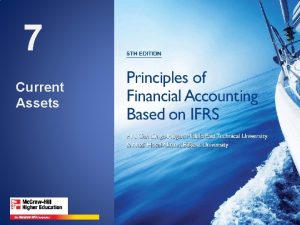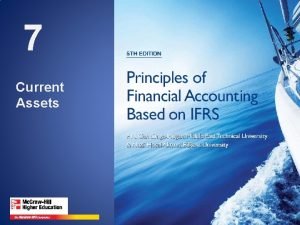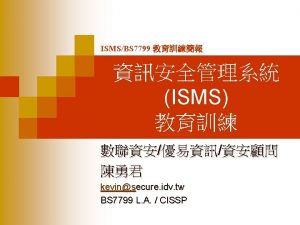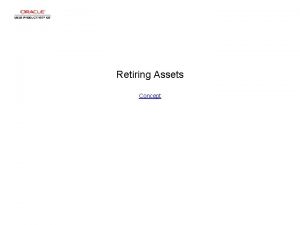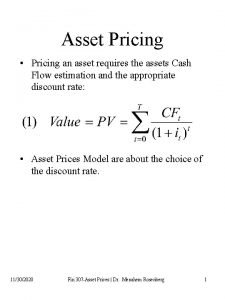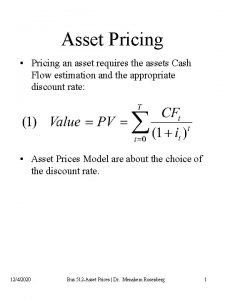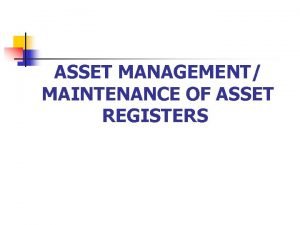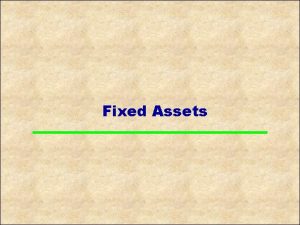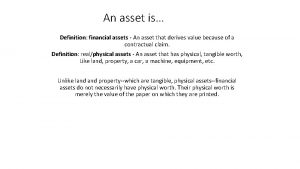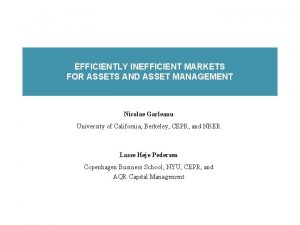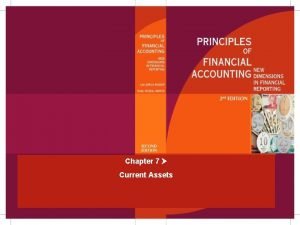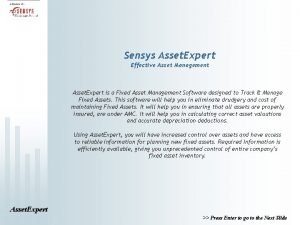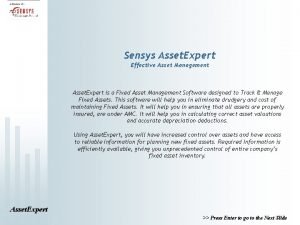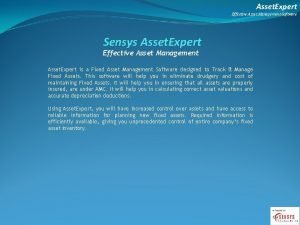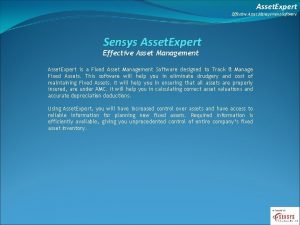Chapter 11 Asset Markets Assets u An asset



























- Slides: 27

Chapter 11 Asset Markets

Assets u An asset is a commodity that provides a flow of services over time. u E. g. a house, or a computer. u A financial asset provides a flow of money over time -- a security.

Assets u Typically asset values are uncertain. Incorporating uncertainty is difficult at this stage so we will instead study assets assuming that we can see the future with perfect certainty.

Selling An Asset u Q: When should an asset be sold? u When its value is at a maximum? u No. Why not?

Selling An Asset u Suppose the value of an asset changes with time according to

Value Selling An Asset Years

Selling An Asset Maximum value occurs when That is, when t = 50.

Value Selling An Asset Max. value of $24, 000 is reached at year 50. Years

Selling An Asset u The rate-of-return in year t is the income earned by the asset in year t as a fraction of its value in year t. u E. g. if an asset valued at $1, 000 earns $100 then its rate-of-return is 10%.

Selling An Asset u Q: Suppose the interest rate is 10%. When should the asset be sold? u A: When the rate-of-return to holding the asset falls to 10%. u Then it is better to sell the asset and put the proceeds in the bank to earn a 10% rate-of-return from interest.

Selling An Asset The rate-of-return of the asset at time t is In our example, so

Selling An Asset The asset should be sold when That is, when t = 10.

Value Selling An Asset slope = 0. 1 Max. value of $24, 000 is reached at year 50. Years

Value Selling An Asset slope = 0. 1 Sell at 10 years even though the asset’s value is only $8, 000. Max. value of $24, 000 is reached at year 50. Years

Selling An Asset u What is the payoff at year 50 from selling at year 10 and then investing the $8, 000 at 10% per year for the remaining 40 years?

Selling An Asset u What is the payoff at year 50 from selling at year 10 and then investing the $8, 000 at 10% per year for the remaining 40 years?

Selling An Asset So the time at which an asset should be sold is determined by Rate-of-Return = r, the interest rate.

Arbitrage u Arbitrage is trading for profit in commodities which are not used for consumption. u E. g. buying and selling stocks, bonds, or stamps. u No uncertainty all profit opportunities will be found. What does this imply for prices over time?

Arbitrage u The price today of an asset is p 0. Its price tomorrow will be p 1. Should it be sold now? u The rate-of-return from holding the asset is I. e.

Arbitrage u Sell the asset now for $p 0, put the money in the bank to earn interest at rate r and tomorrow you have

Arbitrage u When is not selling best? When I. e. if the rate-or-return to holding the asset the interest rate, then keep the asset. u And if then so sell now for $p 0.

Arbitrage u If all asset markets are in equilibrium then for every asset. u Hence, for every asset, today’s price p 0 and tomorrow’s price p 1 satisfy

Arbitrage I. e. tomorrow’s price is the future-value of today’s price. Equivalently, I. e. today’s price is the present-value of tomorrow’s price.

Arbitrage in Bonds u Bonds “pay interest”. Yet, when the interest rate paid by banks rises, the market prices of bonds fall. Why?

Arbitrage in Bonds u. A bond pays a fixed stream of payments of $x per year, no matter the interest rate paid by banks. u At an initial equilibrium the rate-of-return to holding a bond must be R = r’, the initial bank interest rate. u If the bank interest rate rises to r” > r’ then r” > R and the bond should be sold. u Sales of bonds lower their market prices.

Taxation of Asset Returns u rb is the before-tax rate-of-return of a taxable asset. u re is the rate-of-return of a tax exempt asset. u t is the tax rate. u The no-arbitrage rule is: (1 - t)rb = re u I. e. after-tax rates-of-return are equal.

Financial Intermediaries u Banks, brokerages etc. – facilitate trades between people with different levels of impatience – patient people (savers) lend funds to impatient people (borrowers) in exchange for a rate-of-return on the loaned funds. – both groups are better off.
 Real versus financial assets
Real versus financial assets Real assets vs financial assets
Real assets vs financial assets Real assets vs financial assets
Real assets vs financial assets Truck and plant assets
Truck and plant assets Accumulated depreciation straight line method
Accumulated depreciation straight line method Lanni products is a start up computer
Lanni products is a start up computer Plant assets, natural resources, and intangible assets
Plant assets, natural resources, and intangible assets Managing assets vs asset management
Managing assets vs asset management Managing assets vs asset management
Managing assets vs asset management Why study financial markets and institutions?
Why study financial markets and institutions? Chapter 4 cultural dynamics in assessing global markets
Chapter 4 cultural dynamics in assessing global markets Black box model consumer behaviour
Black box model consumer behaviour Chapter 9 expanding markets and moving west
Chapter 9 expanding markets and moving west Business markets and business buyer behavior ppt
Business markets and business buyer behavior ppt Business markets and business buyer behavior
Business markets and business buyer behavior Chapter 18 the markets for the factors of production
Chapter 18 the markets for the factors of production Business buyer behavior refers to the
Business buyer behavior refers to the Analyzing consumer markets chapter 6
Analyzing consumer markets chapter 6 Chapter 5 consumer markets and buyer behavior
Chapter 5 consumer markets and buyer behavior Firms in competitive markets chapter 14 ppt
Firms in competitive markets chapter 14 ppt Chapter 9 expanding markets and moving west
Chapter 9 expanding markets and moving west Chapter 9 expanding markets and moving west
Chapter 9 expanding markets and moving west Chapter 7 consumers producers and the efficiency of markets
Chapter 7 consumers producers and the efficiency of markets Examples of intangible assets
Examples of intangible assets Chapter 4 transactions that affect assets
Chapter 4 transactions that affect assets Impairment of intangible assets
Impairment of intangible assets Chapter 12 intangible assets
Chapter 12 intangible assets Capital=assets+liabilities
Capital=assets+liabilities
